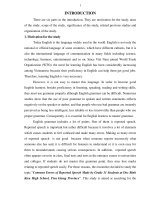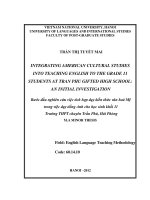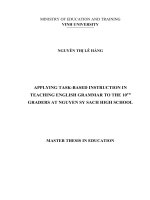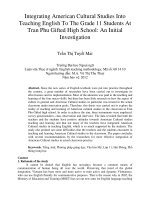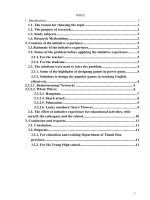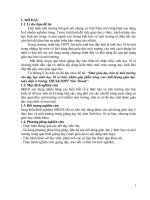Methodologies of teaching english vocabularies in grade 6 in quan hoa secondary and high school
Bạn đang xem bản rút gọn của tài liệu. Xem và tải ngay bản đầy đủ của tài liệu tại đây (102.8 KB, 17 trang )
Methodologies of teaching English vocabularies in grade 6 in Quan Hoa secondary and high
school
TABLE OF CONTENT
Page
PART A: INTRODUCTION.......................................................................................................3
1.Rationale……………………………………………………………………………3
2. Objectives:................................................................................................................................ 4
3. Scopes of the study:.................................................................................................................4
4. Methods of the study………………………………………………………………4
5. Design of the study…………………………………………………………………4
PART B: CONTENTS................................................................................................................6
I. General information about vocabulary: .........................................................................6
1. Definition of vocabulary:.......................................................................................................6
2. The importance of vocabulary:.............................................................................................6
3. Which word to learn……………………………………………………………6
II. Some useful methods of teaching English vocabulary................................................7
1. Drawing pictures: .................................................................................................................. 7
2. Using realia............................................................................................................................. 7
3. Giving examples..................................................................................................................... 8
4. Miming and Total Physical Response……………………………………………9
5. Using synonyms...................................................................................................................... 9
6. Using antonyms.................................................................................................................... 10
7. Acting it out.......................................................................................................................... 10
8. Brainstorming..................................................................................................................... 11
9. Pointing…………………………………………………………………………11
10. Naming ............................................................................................................................. 12
11. Writing a story.................................................................................................................. 12
1
Methodologies of teaching English vocabularies in grade 6 in Quan Hoa secondary and high
school
12. Word of the Day………………………………………………………………12
13. Teaching topic vocabulary...............................................................................................13
14. Root analysis.................................................................................................................... 13
15. Using word chain............................................................................................................. 14
III. Result of the study……………………………………………………………14
PART C: CONCLUSION……………………………………15
References…………………………………………………………16
PART A: INTRODUCTION
1. Rationale
2
Methodologies of teaching English vocabularies in grade 6 in Quan Hoa secondary and high
school
Nowadays, English is considered as the most crucial part in our life. It appears
in almost necessary materials in all fields in the world, so it can help people in such an
important work. If people don’t know something, they can use their English that they
have learnt before to read and use materials effectively. Furthermore, we can use
English to communicate with other people in the world to exchange our knowledge and
experience. From that, we can enrich our soul and deepen our knowledge. Moreover,
we are living in science and technology society where English has its own value. If we
want to integrate in modern civilizations in the world we have to be good at English.
With the meaningful contributions of English, English has become a main subject of
many schools in our country in recent years.
However, learning new thing is difficult and English has no exception. It is true
that there are a vast number of new words and phrases that English learners have to
face up with. Students often find it difficult to learn and remember all the vocabularies
in the English class. As a teacher of English in mountainous areas, I realize that English
may be a struggle subject for students. Therefore, the method of teaching new words
seemed to be a golden key for learners.
From the above mentioned reasons, I would like to introduce the study on
“Methodology of teaching English vocabulary in secondary schools” to investigate the
easiest way of teaching glossary for students to understand and remember. I do my
research with the hope of giving some background knowledge and essential
information about methods of teaching vocabulary for people who pay attention to.
Furthermore, my research can help the teachers of English and students teach and study
English bettersomeday.
2. Objectives
With the above reasons,I myself would like to offer some suggestions on guiding
students to learn and use their vocabulary in the most effective way to enhance
thestudent’s ability to speak, write and translatepassage better.
3
Methodologies of teaching English vocabularies in grade 6 in Quan Hoa secondary and high
school
3. Scope of the study
- About the way of learning and use of English word.
- Methods of teaching English vocabulary.
- The skills of learning Englishvocabulary.
- The students in grade 6 in Quan Hoa secondary and high school.
4.Methods of the study
To achieve the aims and objectives above, a combination of different methods was
used in this study. They are:
-
Collecting materials and data, summarizing and analyzing information from
reference books as well as accessing information on web pages from the Internet.
Consulting specialists.
Personal evaluating the information and the result.
Listing, categorizing types of information.
5. Design of the study
The study is organized into three parts:
-
Part A is the introduction. It includes the rationale of choosing the topic, the
objectives of the study, the scope of the study as well as the methods to be applied.
- Part B is the development. This part consists of two small part as follows:
+ Part I discusses the general information about vocabulary. In this part, the
author of this study presents the generalization of vocabulary, provides some
information about the role of vocabulary and which word to learn.
+ Part II deals with the development of the study. This part investigates, analyze
and comment the methods of teaching vocabulary through these main types: drawing
pictures, using realia, giving examples, miming and total physical response, using
synonyms, using antonyms, acting it out, brainstorming, pointing, naming, word of the
day, writing a story, teaching topic vocabulary, root analysis, using word chain.
4
Methodologies of teaching English vocabularies in grade 6 in Quan Hoa secondary and high
school
-
+Part III gives the result of the study.
Finally, the study close with part C, the conclusion, which gives a summary of
the whole study, carries out the limitation of it and provides suggestions for further
study.
PART B: CONTENTS
I. General information about vocabulary
1. Definition of vocabulary
There are a lot of definitions of vocabulary, but in my research I would like to
introduce some definitions which is familiar to us.
“A person's vocabulary is the set of words within a language that are unfamiliar to that
person. A vocabulary usually develops with age, and serves as a useful and
fundamental
tool
for
communication
and
acquiring
knowledge”.(
From
Wikipedia).Recent vocabulary studies draw on an understanding of lexis, the Greek
for word, which in English “refers to all the words in a language, the 2 Teaching
Vocabularyentire vocabulary of a language” (Barcroft, Sunderman, & Schmitt, 2011,
p. 571).
So vocabulary can be defined as the words of a language, includingsingle items
and phrases or chunks of several words which covey a particular meaning, the way
5
Methodologies of teaching English vocabularies in grade 6 in Quan Hoa secondary and high
school
individual words do. Vocabulary addresses single lexical items—words with specific
meaning(s)—but it also includes lexical phrases or chunks.(Lewis, 1993)
2. The importance of vocabulary
Vocabulary is central to English language teaching because withoutsufficient
vocabulary students cannot understand others or expresstheir own ideas. Wilkins
(1972) wrote that “. . . while without grammarvery little can be conveyed, without
vocabulary nothing can be conveyed”(pp. 111–112).
Learning vocabulary is a very important part of learning a language. The more
words you know, the more you will be able to understand what you hear and read; and
the better you will be able to say what you want to when speaking or writing.
3. Which word to learn.
Every day you hear or read many new English words. You also find them in
your dictionary when you are translating from your own language. You can’t possibly
learn all these new words, so your first problem is to decide which ones to concentrate
on. Here are some suggestions:
-Learn the words that are important to the subjects you are studying
-Learn the words that you read or hear again and again
-Learn the words that you know you will often want to use yourselfdo not learn words
that are rare or not useful (your teacher can help you with this).
II. Some useful methods of teaching English vocabulary.
1.
Drawing pictures :
Teachers can guide students to draw simple pictures from that the children could
remember new words longer. They can paint and learn in the same time. By this way
students can find it easy to learn and remember the word that they have studied.
Example:
A bike: (một chiếc xe đạp)
A car :(một chiếc xe hơi)
6
Methodologies of teaching English vocabularies in grade 6 in Quan Hoa secondary and high
school
Atelevision :(một cái ti vi )
An o clock :(một cái đồng hồ )
’
2. Using realia
The use of realia, or real-life objects in the ESL classroom can make a huge
difference in student learning. It engages them and motivates them to learn. It’s fun and
sets a more natural learning environment. Some realia you may use to introduce new
vocabulary includes:
Maps
Tea sets, dishes, and utensils
Clothes
Toy planes, trains, cars, animals, furniture, etc…
Family photos
Holiday items (pumpkin, Easter eggs, Halloween or Christmas decorations)
Plastic fruits and vegetables
Teacher can guide for children to use some materials surroundings theirs life. By this
way students can easy to apply and easy to remember. When they forget the new word
that they have studied before, they can directly watch the real materials and read them
aloud. From that they can both learn a word again and remember the new word.
For example:
With the new word related to the household appliances and the word about the animals,
teacher can guide student to learn by pointing the real material and ask student to read
aloud the word. They can practice this method of learning with their friend at home.
3.
Giving examples
Take example when learning English is considered as the most effective way of
learning new word. Students not only learn by heart new word but they also know how
to use new word correctly in right context. From each example students get, they
become more confident to use that new word in other time. Taking examples when
learning English means that you have achieved a new level of learning. It gives you
7
Methodologies of teaching English vocabularies in grade 6 in Quan Hoa secondary and high
school
confidence and a little bit success for learning. You have your own right to hope in your
learning.
Example:
Teacher wants to teach these words:
A table
Some flowers
A book
School
Students can give some examples like:
This is a table.
There are some flowers on the table.
My book is nice.
My school is in the country
4.
Miming and Total Physical Response
This technique works great with kinesthetic learners, namely those who learn best by
moving their bodies. Most teachers believe that mining works best with children,
particularly when it comes to exaggerating emotions and facial expressions, but adults
may also enjoy miming.After explaining new vocabulary, you can then ask the
students to perform the actions. This can work with simple words like blink or sneak,
or more complex ones like eat a sandwich or read a book.
Most teachers are also aware of the advantages of Total Physical Response in the ESL
classroom. Total Physical Response works well with parts of the body
Example:
(I’m touching my nose! Touchyour nose!), actions (I’m walking to the door), and
the imperative mood or commands (Sit down! Stand up!)
The main advantage in miming and Total Physical Response is that you can get
students physically engaged in the lesson. It gets them out of their seats and shakes
things up. So make sure you maximizeopportunities to get them moving.
5. Using Synonyms
These can be effective since they build on words and phrases that students
already recognize. Adjectives often have several symptoms, and phrasal verbs will
usually have a non-phrasal verb equivalent. Use caution that you do imply that all the
8
Methodologies of teaching English vocabularies in grade 6 in Quan Hoa secondary and high
school
words have exactly the same meaning, since different words often are used for
different connotations or to imply different meanings.
Example 1:
Teacher wants to teach the word “recess” she should give the word “break” or the
word “unhappy” she should give the word “sad” ; or the word “remember” she should
ask students that this word has the same meaning with “don’t forget”.
Example 2:
Play football = play soccer: chơi bóng đá
Corn = maize: ngô , bắp
To learn = to study: học
A bike = a bicycle: một chiếc xe đạp
Lemon juice = lemonade: nước chanh .
6. UsingAntonyms:
Like synonyms, antonyms build on words or phrases that students already know. At
lower levels, you can use words like rich and poor. However, this does not work for all
advanced vocabulary lessons, since rich actually has more meanings than "having a lot
of money." For older students, prefixes and suffixes are also helpful.
Example:
Small ( nhỏ ) >< big ( lớn )
Short ( ngắn ) >< long ( dài )
Ugly ( xấu) >< nice ( đẹp )
7. Acting it out
Younger children, especially, respond to games, but older kids don’t generally mind a
little injection of fun into their school days either. Teachers can make vocabulary words
more fun to learn by turning the process into a game, like charades.
Students can take turns acting out one of the vocabulary words, while the other
students guess the word. In order for charades with vocabulary words to work, students
need some basis in the vocabulary, so teachers should schedule the game of charades a
few days after students first get their vocabulary words. Teachers may want to release
the word list on Monday, for instance, and make Friday game day.
8. Brainstorming
9
Methodologies of teaching English vocabularies in grade 6 in Quan Hoa secondary and high
school
Vocabulary builds upon itself, and association with words that are already familiar to
students is one of the most effective means of teaching students unfamiliar words.
Teachers who help students associate new words with words they already know well
will help students with long-term retention.
One method of associating vocabulary words with familiar words is to brainstorm with
students. Once students have heard a word and its definition, teachers can write the
word on the board and ask students to say words that go along with the new vocabulary
word.
Example:
If the word is “mare,” for instance, students might say “horse,” “barn” and “hay.” By
writing the words down together, it creates a visual reference for students.
9. Pointing
Pointing is probably the technique of choice when teaching real beginners. The teacher
shows students illustrations or flashcards and points to the items they wish to teach.
You can also use posters, Power Point presentations, or different types of computer
software where illustrations are presented in electronic format. Google Images is a real
life-saver! Pointing works best with nouns which include food, clothes, animals,
professions, sports, classroom objects, office supplies, etc… but also colors, actions,
and any adjective that can be clearly illustrated (like facial expressions, for example to
teach feelings). The main advantage of pointing is that words may be introduced in
blocks, and you may easily and effectively introduce several in one lesson. Works well
with visual students.
10. Naming
This technique is similar to substitution, but in this case, you set a scene or
situation and then substitute it with a new word or phrase, thus effectively naming the
scene.
Example:
10
Methodologies of teaching English vocabularies in grade 6 in Quan Hoa secondary and high
school
Do you usually eat pancakes, eggs, and bacon for breakfast? (No) So, you have
a light breakfast.
The hotel accepted too many reservations. The hotel is overbooked.
The steak I ordered last night was not cooked enough. It was undercooked/rare/bloody.
11. Writing a Story
A larger vocabulary enhances students’ writing and reading abilities, so what
better way for students to retain words than to use them in stories? Teachers can assign
stories on an individual basis, or make it a class project. By having students incorporate
all their vocabulary words correctly into the text, students get the opportunity to learn
proper spelling and definitions, and also how to use the words in context.
12. Word of the Day
Educators who grew up in the 1980s surely remember “Pee-Wee’s Playhouse”
and “Pee-Wee’s Word of the Day.” When the word of the day was spoken, everyone in
the playhouse, and the kids at home, were supposed to scream.
Teachers who want to encourage students to use their new vocabulary words
(and who can stand a little noise) could benefit from this method. Teachers can make
each day’s word of the day a different vocabulary word, and let students yell whenever
someone says it. Then, at the end of the yell, teachers can remind students of the
word’s definition.
Even teachers will admit vocabulary isn’t the most exciting thing to teach, but
adding fun ways to teach vocabulary words can help keep the process fresh and
entertaining.
13. Teaching topic vocabulary
Students can learn words in the system so that they can easy to remember all
words longer and easy to find words after learning.
Example:
11
Methodologies of teaching English vocabularies in grade 6 in Quan Hoa secondary and high
school
Food
School
Pork
Classroom
Fish
Book
Vegetable
Notebook
Meat
Board
Rice
Desk
14. Root Analysis
While root analysis is taught explicitly, the ultimate goal is for readers to use this
strategy independently. Many of the words in the English language are derived from
Latin or Greek roots. They either contain a “core” root (the primary component of the
word) or use prefixes or suffixes that hold meaning. Adults should focus on teaching
children the most commonly occurring roots, prefixes and suffixes. As each is taught
examples of its use in common word should be shared and examined. The reader
should see how the root helps her understand the word’s definition. Children should
then be given practice analyzing words to determine their roots and definitions. When a
reader is able to break down unfamiliar words into their prefixes, suffixes and roots
they can begin to determine their meanings.
Example:
Teach ( dạy ) – teacher ( giáo viên )
Drive ( lái xe ) – driver ( người lái xe)
Work ( làm việc ) – worker ( công nhân
15. Using word chain.
These methods help students recall the words they have learned before. From that they
help students systemize vocabularies they have learned, and students could remember
more words.
Example:
12
Methodologies of teaching English vocabularies in grade 6 in Quan Hoa secondary and high
school
Nice – eye – egg – girl – learn - note book – key – yellow …..
III.
Result of the study
Before using these studies, a lot of students don’t remember exactly any new
words. So their result is very low. But after applying these methods in grade 6 in Quan
Hoa secondary and high school with 38 students, their result is improved so
considerably.
Chart 1: The result before applying these methods.
Excellent
Total %
0
0
Good
Total
6
%
15,78
Medium
Total
%
16
42,12
Bad
Total
16
%
42,
1
Chart 2: The result after applying these methods.
Excellent
Total %
3
7,89
Good
Total
9
%
23,68
XÁC NHẬN CỦA THỦ TRƯỞNG ĐƠN VỊ
Medium
Total
%
20
52,65
Bad
Total
6
%
15,7
8
Thanh Hóa, ngày 15 tháng 05 năm 2017
Tôi xin cam đoan đây là SKKN của mình viết,
không sao chép nội dung của người khác.
Người viết
Quách Thị Hà
13
Methodologies of teaching English vocabularies in grade 6 in Quan Hoa secondary and high
school
PART C: CONCLUSION
The writer has to say that there are some techniques in teaching vocabulary.
Those are considered effective since they could be applied by English teachers in
teaching vocabulary at secondary school. The techniques are drawing pictures, using
realia, giving examples, miming and total physical response, using synonyms, using
antonyms, acting it out, brainstorming, pointing, naming, word of the day, writing a
story, teaching topic vocabulary, root analysis, using word chain. The use of techniques
14
Methodologies of teaching English vocabularies in grade 6 in Quan Hoa secondary and high
school
also should consider the number of aspects in teaching-learning process, such as; the
teachers' competency, the students' ability, and the allocation of time.
References
1. The vocabulary in use.
2. Teaching Grammar and Vocabulary.
3. Teaching English.
4. English book 6-7-8-9.
5. Carter, R. A., and M. J. McCarthy (2006). Cambridge Grammar of
English.Cambridge: Cambridge University Press.
6. Schmitt, N. (2000). Vocabulary in Language Teaching. Cambridge:
CambridgeUniversity Press.
7. Thornbury, Scott: How to teach Vocabulary, Longman, 2002
8. Nunan David: Language Teaching Methodology, a textbook for teachersLongman ,
2000
15
Methodologies of teaching English vocabularies in grade 6 in Quan Hoa secondary and high
school
16

